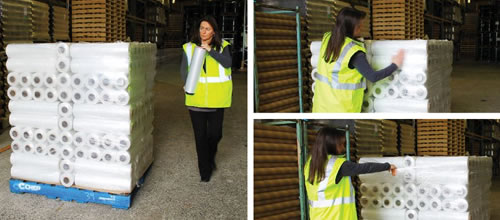How to Hand Wrap a Pallet and addressing OH&S Issues
523
This seems such a simple thing, but how a pallet is wrapped is vitally important to not only you as the end user and receiver, but you as the supplier and the transporter, and you especially as a hand pallet wrapper.
As The End User and Receiver
First of all you want to receive your goods intact.
Damages can occur not only if the goods have fallen off the back of the truck (literally) due to a poorly balanced and wrapped pallet, but also if care hasn't been taken with pallet protection and the boxes have been squashed or crushed by the pallet wrapping. Also - you want to be able to safely access your goods - so it's important they haven't been stacked so high that you end up with O H & S issues in the process of just trying to unload the pallet.
As the Supplier and Transporter
As the supplier of goods you want to make sure your goods arrive intact and in good condition. What condition your goods arrive in are a reflection on you - and any business wants to make sure there will be repeat business.
You - the Pallet Wrapper
Its important to think about your physical actions involved in the process of wrapping your pallet. doing it correctly and using the right assistance - whether it be in the type of stretch wrapping dispenser, or a pallet lift elevator assisting you in lifting the pallet more to your height - can make the difference in having an injury or not having an injury caused by hand wrapping pallets
So How Do I Wrap a Pallet?
- Start by attaching the stretch wrap to either the load or the pallet. Commonly the film is slotted between layers of product at the bottom of the load.
- Note that the the tack of stretch film is on the outside layer, so ensure the film is applied with the tack against the load.
- Start at the base. The first wrap should have a 3 inch overlap of the base and should be wrapped a couple of times to ensure optimum stability and strength. From there on you spiral upward with the stretch wrap ensuring each subsequent wrap covers the previous wrap by atleast 50%. When the top is reached ensure another 3 inch overlap for added strength and stability and then come back down again to complete the wrap. Cut the wrap atleast 300mm past the corner and then tuck or wipe the film back onto itself.

Best Practice and applying Occupational Health and Safety Hints to hand wrapping pallets
- It is best to walk forward around the pallet using forward momentum (as opposed to a backward pulling motion). This is not only safer for your back, but also avoids tripping incidents.
- Use tension at the corners of the pallet, but then release the tension to allow the film to unwind freely. Rather than applying tension at the corners, simply take a side ways step around the corner without releasing film.
- Using a pre-stretched pallet wrap requires less physical tension.
- Whilst bending can't be completely avoided whilst hand wrapping a pallet you can reduce how far you need to bend by ensuring goods are placed on a pallet. Or, you can use a Pallet Lift Elevator or Scissor Lift to lift your load off the ground.
- Using a Metal Hand Pallet Dispenser can also reduce the depth of bending.
- Alternatively you can use a pallet wrapping machine, or pallet wrapping trolley.
Extras available to assist in protecting your pallet of goods
- strap the pallet - by either using a Pallet Strapping Machine or by Hand Strapping
- Pallet Corners (also known as edge protectors) which protect the edge of pallets thereby ensuring the integrity of the box remains
- Pallet Bags are a plastic bag that is big enough to fit over a pallet of goods and is then shrunk using a heat gun to snugly fit and secure a load
- Grip Sheets are placed between layers of boxes to hinder slippage of the load
All of these items and more are listed under Pallet Stabilization and Protection Products.







